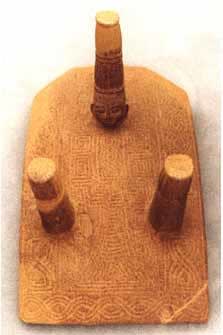Basalt Ceremonial Metate, 100 CE - 500 CE
Basalt
36.5
PF.4868
The Ancient Costa Ricans share with the Egyptians the remarkable ability of making functional objects that have a ceremonial purpose. The metate was used to grind corn and other foods....
The Ancient Costa Ricans share with the Egyptians the remarkable ability of making functional objects that have a ceremonial purpose. The metate was used to grind corn and other foods. It was also a symbol of wealth and power for the noble classes whose absolute control made the growing and harvesting of food possible. Going a step further, certain metates had a purely ceremonial use, particularly ones such as this very lovely example. A curved top or plate indicates this metate was made in the Guanacaste-Nicoya Zone. When placed upright it would have been suitable for grinding food for ritual ceremonies. However, turned onto its end an entirely different perspective appears. Carved at the bottom of one leg is a very fine head, with the upper section acting as a sort of conical headdress. The two bottom legs can be interpreted as the person's own legs; while the elaborate pattern on the background may be seen as flowing hair, or a beautiful cloak. The low-relief carving is an extraordinary blending of interlacing geometric shapes, perhaps representing the woven mat that was a common sign of authority in Meso-America. No matter, which way this metate is turned, it is suitable for a royal resistance as property of a king.



